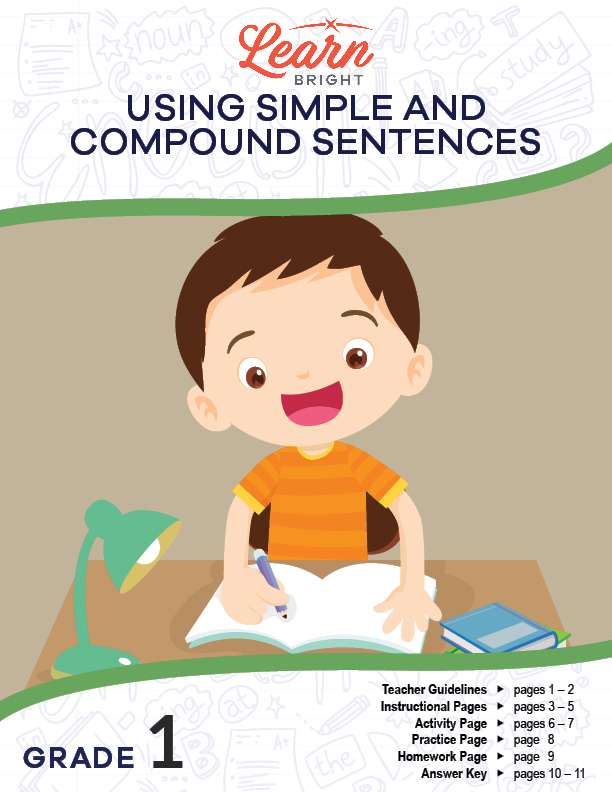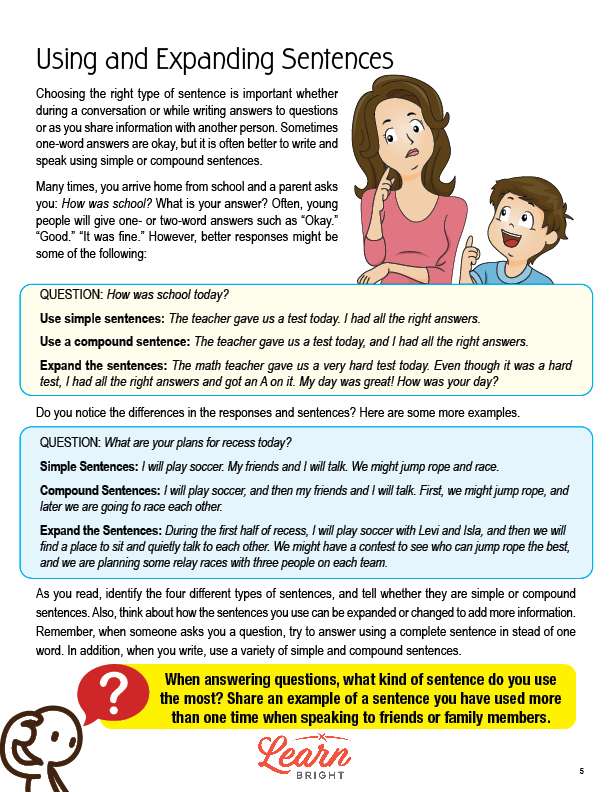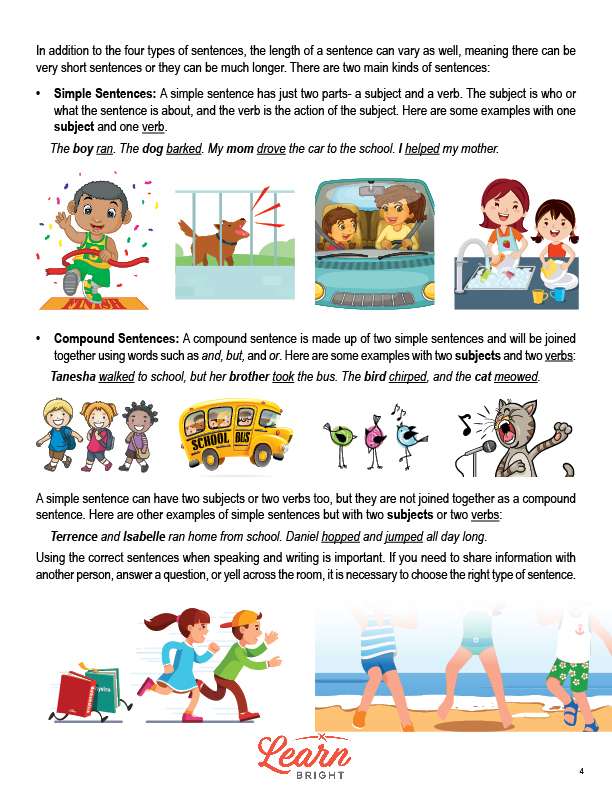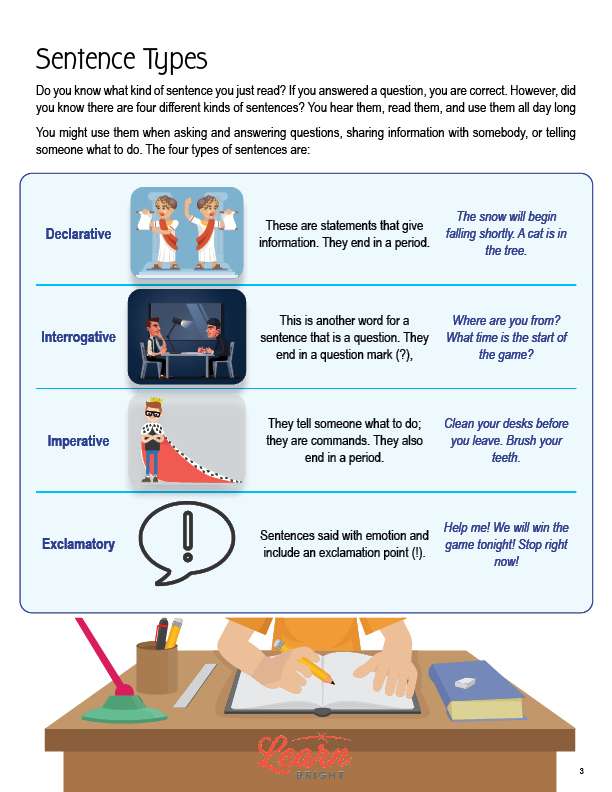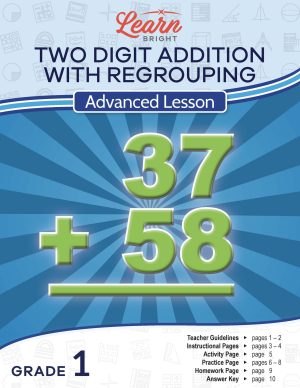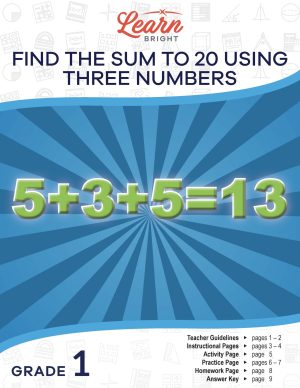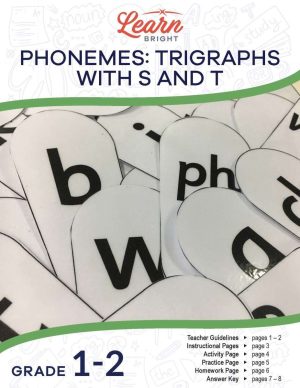Description
What our Using Simple and Compound Sentences lesson plan includes
Lesson Objectives and Overview: Using Simple and Compound Sentences teaches students about different sentence types and how to form and use them. At the end of the lesson, students will be able to produce and expand complete simple and compound declarative, interrogative, imperative, and exclamatory sentences in response to prompts.
Classroom Procedure
Every lesson plan provides you with a classroom procedure page that outlines a step-by-step guide to follow. You do not have to follow the guide exactly. The guide helps you organize the lesson and details when to hand out worksheets. It also lists information in the green box that you might find useful. You will find the lesson objectives, state standards, and number of class sessions the lesson should take to complete in this area. In addition, it describes the supplies you will need as well as what and how you need to prepare beforehand. For this lesson, the only supplies you will need are scissors and the handouts. To prepare for this lesson ahead of time, you can pair students for the activity, gather the supplies, and copy the handouts.
Options for Lesson
Included with this lesson is an “Options for Lesson” section that lists a number of suggestions for activities to add to the lesson or substitutions for the ones already in the lesson. The first two suggestions are related to the activity worksheet. You can expand the activity worksheet by creating additional sentence parts for your students to use. You can also have students use the sentences they create during the activity to create a fun and creative poster! To give students more practice, you can have students identify different types of sentences in text they’re currently reading. Finally, you can expand the lesson by holding a “Sentence Bee” for your students, where they either identify a type of sentence or complete a sentence using a sentence part you provide.
Teacher Notes
The teacher notes page includes a paragraph with additional guidelines and things to think about as you begin to plan your lesson. It notes that students should already understand the basics when it comes to sentences and sentence types. This lesson will reinforce their writing skills. This page also includes lines that you can use to add your own notes as you’re preparing for this lesson.
USING SIMPLE AND COMPOUND SENTENCES LESSON PLAN CONTENT PAGES
Sentence Types
The Using Simple and Compound Sentences lesson plan includes three content pages. The lesson begins by asking students if they know what type of sentence they just read and if they knew that there are four different kinds of sentences. We use all of the types of sentences every day. We use them when we ask or answer questions, when we share information with other people, and when we tell people what we want to do! The four types of sentences are declarative, interrogative, imperative, and exclamatory.
The lesson includes a chart that shows each type of sentence, their definition, and an example of that type of sentence. Declarative sentences are statements that give information and end with a period. Interrogative sentences are sentences that are questions and end with a question mark. Imperative sentences are commands that tell someone what to do. They end with exclamation points. Finally, exclamatory sentences are sentences that you say with emotion and end with an exclamation point.
Next, students will learn that sentences can also be either short or long. There are two main kinds of sentences: simple and compound. Simple sentences contain a subject and a verb. Subjects are what the sentence is about, while verbs are the action of the subject. The lesson includes some examples of simple sentences, such as “The boy ran”.
Compound sentences are two simple sentences joined together by a word like and or but. The lesson also includes some examples of compound sentences. Students will also learn that simple sentences can have two subjects or two verbs and still be simple sentences if they are not joined together like a compound sentence. The lesson gives a few examples of this as well. The lesson also notes that it’s very important to use the right kind of sentence when writing or speaking!
Using and Expanding Sentences
The next section of the lesson begins by reiterating that it’s important to make sure you choose the right kind of sentence when speaking or writing. The lesson gives the example of coming home from school and responding to your parents asking how your day was. It’s better to respond with a full simple or compound sentence than a one or two word answer! The lesson provides an example of a response that you could use that’s a simple sentence, a response that’s a compound sentence, and a response that’s expanded and includes even more information. The lesson also provides a second set of examples.
Students can practice identifying the four different types of sentences as they read. They can also practice determining whether a sentence is a simple sentence or a compound one. Students should also consider how they could expand or change a sentence to include more information. Answering questions with full sentences is better than using a simple one or two word answer, and using both simple and compound sentences in your speaking and writing will make it more interesting!
USING SIMPLE AND COMPOUND SENTENCES LESSON PLAN WORKSHEETS
The Using Simple and Compound Sentences lesson plan includes three worksheets: an activity worksheet, a practice worksheet, and a homework assignment. You can refer to the guide on the classroom procedure page to determine when to hand out each worksheet.
SENTENCE PARTS ACTIVITY WORKSHEET
Students will work with a partner to complete the activity worksheet. The activity contains two parts. For part 1, students will cut out the provided sentence parts and join them together to make different kinds of sentences. They will write these sentences in the space provided on the worksheet. For part 2, students will work with their partner to take turns writing and answering questions. Students will switch off writing the questions and answering them.
Students may work either alone or in groups for this activity if you’d prefer.
USING SIMPLE AND COMPOUND SENTENCES PRACTICE WORKSHEET
For the practice worksheet, students will complete a few different exercises. The first exercise asks them to match the sentence types with the correct meaning and example. The sentence types they will be matching for this section are interrogative, declarative, imperative, and exclamatory. The second exercise asks students to complete various sentences that are missing parts. The third asks them to answer questions with complete simple sentences, while the fourth asks them to answer questions with complete compound sentences. Finally, students will write two sentences: one simple and one compound.
SENTENCE TYPE IDENTIFICATION HOMEWORK ASSIGNMENT
The homework assignment asks students to first look at images and write different types of sentences pertaining to those images. Next, they will read sentences and determine if they’re compound or simple sentences. Finally, they will complete sentences in a paragraph by filling in the blanks and using their imagination.
Worksheet Answer Keys
This lesson plan includes answer keys for the practice worksheet and the homework assignment. No answer key is provided for the activity worksheet because students’ answers will vary. If you choose to administer the lesson pages to your students via PDF, you will need to save a new file that omits these pages. Otherwise, you can simply print out the applicable pages and keep these as reference for yourself when grading assignments.

